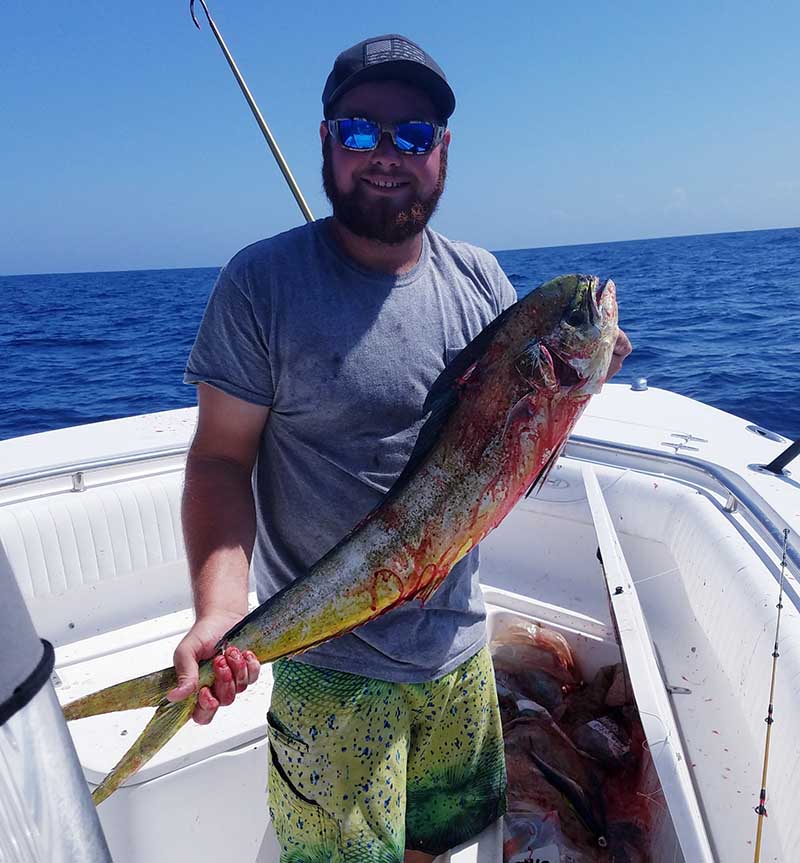
With June upon us, the seas should start calming down and smoothing out so smaller boats will be able to have more time offshore. The end of the spring mahi run will be over soon but there will still be some that stay in the area throughout the summer months. Trolling ballyhoo and lures from 80 foot on out will be the way to locate them. Look for floating debris, weeds, birds, schools of bait fish and rips. Once any of these are found, make a pass or two by them to see if anyone is home. If nothing hits your spread, it is a good idea to toss some chunk bait or some live baits as close to the debris without getting tangled with the debris.
Kingfish will be moving into our area this month. When fishing for kings, I recommend using a fast tip rod to keep steady pressure on the fish. A reel with fast line retrieval is the way to go for getting all the slack line back in fast if your fish is swimming back towards the boat. Many of these fish can be foul hooked so be sure to keep light drag with steady pressure (no jerking).
Look for kings in the depths of 15 foot off the beach to out to 80 foot. For kingfish you can troll a drone spoon or ballyhoo 40 to 50 foot behind your boat, but I would suggest having one below the surface in midwater depth with a downrigger or a planer. My preferred way of fishing for kingfish is looking for the bait schools and then slow troll a live threadfin, pilchard or a big blue runner with a live bait hook through the nose and a treble hook (also known as “stingers”) near the tail as kingfish like to strike short. Always use wire leader as these fish have razor sharp teeth and will cut through mono like butter. Then use wire to attach the nose hook to the treble hook.
Kingfish can also be found in the deeper waters around structure or hard bottom. Troll live baits around these areas and keep watch at your depth finder for bait pods on the bottom. Kingfish will usually be near these bait pods and structure. In the deeper depths you should cover the water column. I recommend using a downrigger if available and put it halfway down between the surface and the bottom and then have your other baits at the surface. Some days all your bites will be on the surface baits and some days on the downrigger baits and other days you will have bites on both the downrigger and surface baits. The live baits in our area for kingfish are pilchards, threadfin herring and you can’t ever go wrong with a big blue runner. I suggest putting the big blue runner on the downrigger, if possible, or on the surface he should be the farthest line out in your spread. All of these baits can be caught in our local waters.
Kingfish are edible. Smaller kingfish are good on the grill or broiled. Bigger kingfish are great smoked. There are also many good fish smack (fish dip/spread) recipes that you can find on the internet.
If the smaller kingfish are schooled up and you have had your fill of catching kingfish, watch your bottom machine, many times you can drop baits to the bottom in the same area and catch snapper. Snapper hang under schools of kingfish to eat the leftover bait pieces that the kingfish are eating.
Enjoy all the fishing opportunities we will have this month. Check your rules and regulations and catch’em up. Remember keep an eye on the sky for any afternoon storms.
FORECAST BY: Capt. Danny Markowski
LottaBull Fishing Charters
Phone: (772) 370-8329
Email: lottabull4@bellsouth.net
www.lottabullfishingcharters.com




